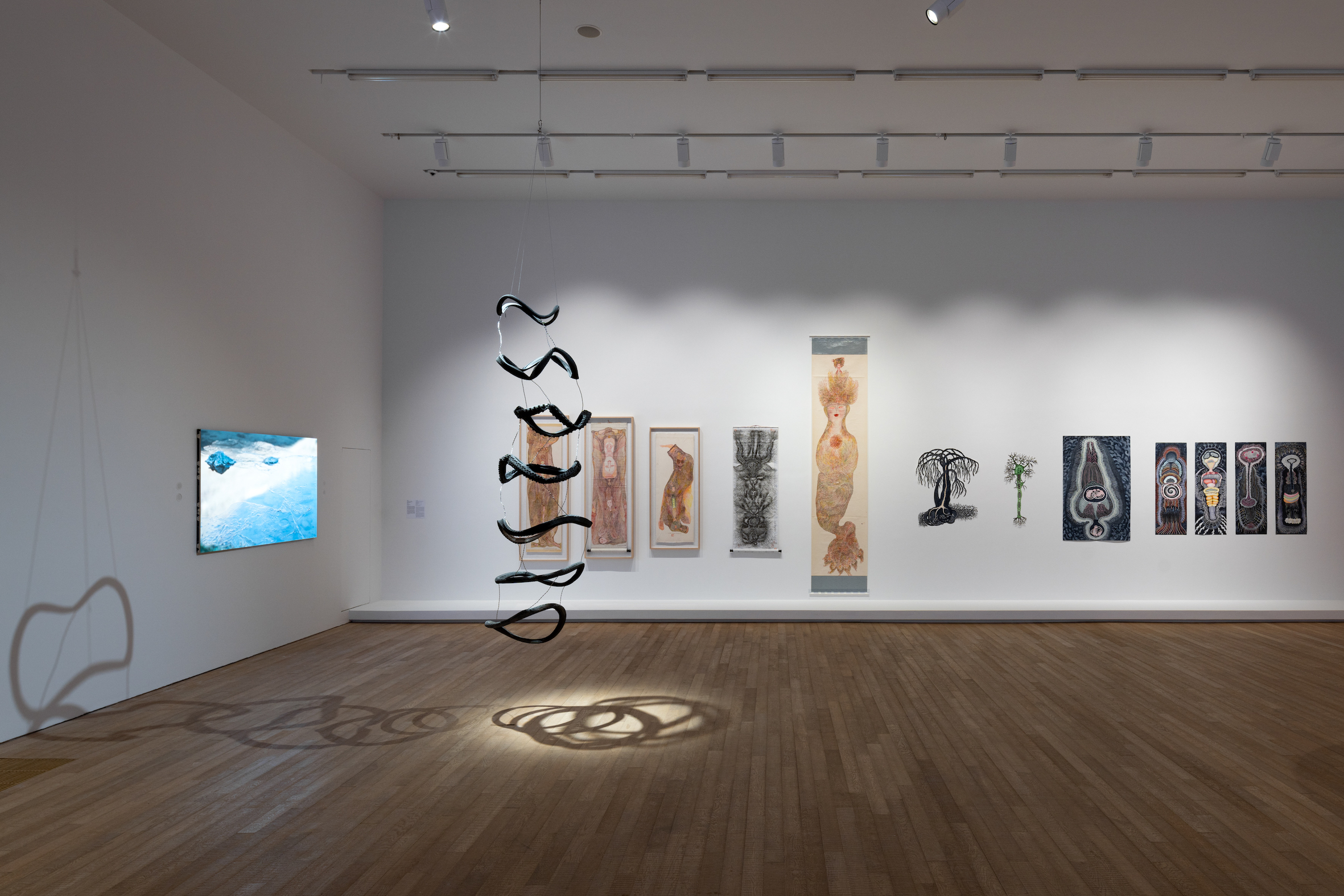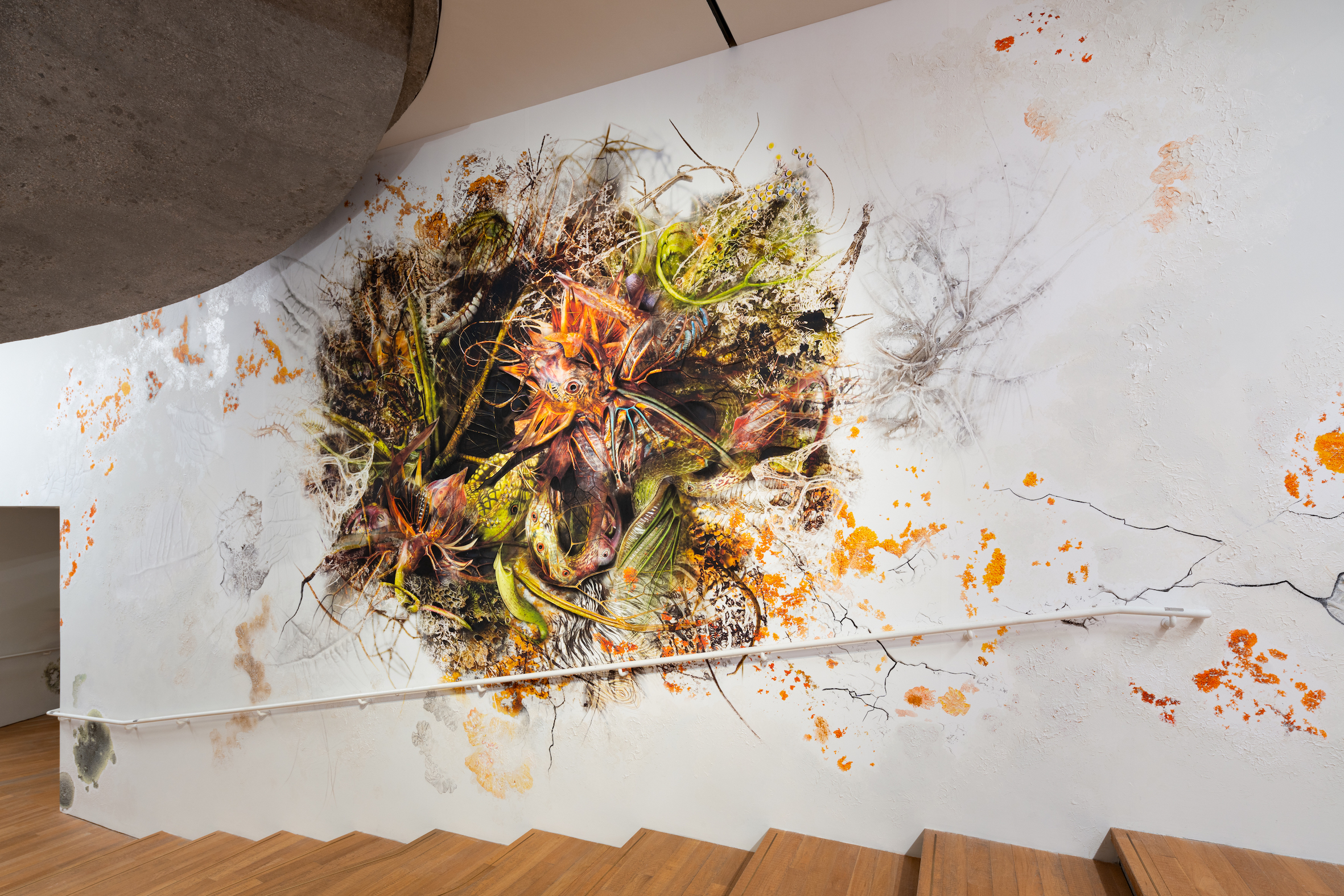Shows
Artworks That Animate “Green Snake: Women-centered ecologies”
.jpg)
.jpg)
Dec 20, 2023–Apr 1
“Green Snake: Women-centered ecologies”
Tai Kwun Contemporary
Hong Kong
It’s official: 2023 was the hottest year on record. If the urgency of radical climate reform isn’t apparent enough, this recent news ought to incentivize the institutions that oversee our global, extractivist-capitalist system. But on the micro level, individuals have long sought to establish new pathways for how humankind can engage with the Earth. Tai Kwun Contemporary’s latest group exhibition, “Green Snake: Women-centered ecologies,” spotlights recent efforts by approximately 30 international artists and collectives, many of whom respond to exploitative systems in the Global South and beyond.
Co-curated by Kathryn Weir and Xue Tan, “Green Snake” is an ambitious attempt to bring ecofeminism—the intersection of environmental and gender-based activism—into Hong Kong’s discursive consciousness. In the courtyard of Tai Kwun visitors are confronted by London- and Guyana-based artist Yussef Agbo-Ola’s architectural commission, MIKA – 8 ROOT TEMPLE (2023), a six-by-six-meter brick, bamboo, and cotton fibre structure that appears like a vertical microfarm, with small specimens planted throughout. Unfortunately, many of these plants had wilted upon ahead of our visit.
With the overwhelming density of a rainforest, each corner of the gallery, including small stairwells, featured artworks of varying sizes and media—a mural here, a video there. To stop and crowd passageways to view a work felt occasionally awkward, but to skip over it felt unfair. In places, the conceptual backbone of the exhibition, ecofeminism, began to feel more distant. While intersectionality should be celebrated whenever it can, curators’ inclusion of 60-plus artworks with distinct and complex narratives potentially muddled what were all unique and interesting works.
That said, the exhibition succeeded in forging a space of hope and solidarity, from a myriad of perspectives and peoples, in a city not known for its activist outreach. Less might have been more in this case, but after sifting through the narratives, we have chosen a few artists whose works left strong impressions and captured key themes from “Green Snake.”
.jpg)
Dima Srouji
Ecofeminist art can sometimes feel more conceptual than activist, but Palestinian artist Dima Srouji’s installation is both moving and educational, particularly amid the ongoing violence in Gaza. Composed of a suspended glass sculpture, The red river, and a wall-mounted short film, She still wears kohl and smells like roses (both 2023), her works explicate the history of the Na’aman River in Haifa Bay. Once an alchemistic beacon for Palestinian communities and a major resource for the ancient glass-making industry, pollution from Israeli infrastructure has now disturbed the natural landscape, hence the red coloring. The river sculpture is complemented by Srouji’s 14-minute video-essay, which depicts archival footage from Palestine of glass-blowing and perfume-making, as many of the glass vitrines were used to hold Palestinian women’s fragrance and cosmetics. In stark contrast to recent images of the region—countless photographs of wartime destruction that evoke a depressing finality—Srouji’s artwork revives Palestinian culture and history as much as it mourns it. AL
Lhola Amira
At the heart of the gallery, there is a portal. Titled Khuphuka Sthunywa (To heal: ascend the messenger) (2023), the work was constructed by Cape Town-based artist Lhola Amira, whose practice draws on Nguni spirituality to foster healing and connection. Khuphuka Sthunywa is, most basically, a circular, glass-beaded curtain hovering over a bed of salt. Suspended from the ceiling by fish wire, the curtain delicately conceals whoever enters it and stands upon the salt (shoes must be removed). Only once you are within the structure can you hear a track of soft singing and ambient noise, which somehow obscures the hustle and bustle of the outside world—namely, a crowded gallery space—and transports the viewer into a meditative state. At the same time, feeling the rough, granulated salt beneath your feet is grounding in the most instinctive sense; we were made to connect to the earth in this way, not behind a constant barrier of shoes. Through Khuphuka Sthunywa, Amira thus allows anyone and everyone to experience the power of Indigenous knowledge systems and “ascend the messenger.” AL
.jpg)
Seba Calfuqueo
Seba Calfuqueo’s TRAY TRAY KO (2022) is a six-minute performance-based video captured by filmmaker Sebastián Melo following the artist’s path through a forest in the Bosque Pewen area of Chile. Calfuqueo traverses lush greenery dragging a shimmering blue cloth that seems to imitate the river. A light chiming sound can be heard, the source of which seems to be the artist’s long metal earrings. The trek leads to a waterfall where Calfuqueo navigates through the river to stand under the pool of cascading water and withstand its torrents wearing only a wrap skirt made out of the same material as the cloth they drag. The short film ends with a poem inspired by indigenous Mapuche songs from spiritual healers of a bygone era: “I will bring you a meliko [water plant] remedy / from the midst of the waterfall. / I don’t really know / how to treat this disease anymore. / Perhaps I will be able to manage / your illness with this remedy. / From the blue waterfall I will take / blue flower medicine / to treat your illness. / ‘I’m going to ease it,’ I told you. / That’s why I came. / It is no longer a very treatable disease.” The artist creates ripples that beckon people to act in solidarity for the healing of this sacred forest and its waters from damages caused by continued resource extraction. CAC
Adriana Bustos
Water plays an important role in the origins of life: it's where civilizations begin and how rising empires expand, as seen across the annals of history. In the nearly ten-meter-long painting Afluentes Sudamericanos: carta de navegación (South American tributaries: navigation chart) (2023) Argentinian artist Adriana Bustos creates an illustrated cartography that follows rivers throughout Latin America. Starting from north with the Río Orinoco in Venezuela and Río Magdalena in Colombia, to the Rio de la Plata on the continent’s southeastern coastline and the Beagle Channel between Chile and Argentina, Bustos charts the timeline of European colonization up to modern day through the lens of politics and ecology. Working in the style of 16th-century illustrations produced by European conquistadores, with the depictions of mythical creatures in the past, Bustos draws fish species that have been introduced into South American rivers, adding landmarks of gold mines, factories, and dams that have caused havoc on the environment—revealing how little times have changed since the conquistadores reign. Bustos’s use of color, from a clear blue to a distasteful brown, shows the deteriorating health of the rivers and we see how our futures are mapped to be as murky as ever. CAC
Guo Fengyi
When encountering the works of Guo Fengyi (1942–2010), the fluidity of each pen or brush stroke, diligently repetitive, conveys a state of meditation that can hold within it a moment in time. One of the five artworks on display in “Green Snake” by the late artist from Xi’an, Penguin Gong Follows the Path of Qi within a Human Body (1995) is an amalgamation of circular lines and colors fused together to form slightly distinguishable shapes of serene beings. The large scale in which Guo worked shows how much her personal practice of qigong embodied her life. The reds and yellows are reminiscent of the colors we see behind our eyelids, and the rhythmic lines call to attention the breaths we take and the flow within our bodies. Her studies of qi, an energy that flows through everything and is almost akin to the blood that courses through our veins to achieve spiritual and physical states of balance, calls for a singular focus where all who look are welcomed by a tranquil Buddha to partake in a stillness and mindfulness outside the boundaries of time. CAC
.jpg)
Karan Shreshta
To really experience Karan Shrestha’s installation cloud babies (2023), you have to stand inside the snake-like 1.7-meter-diameter carved wooden ring suspended from the ceiling (it is allowed). From that position it is much easier to see that the sculpture is continuously being tilted ever so gently so that a small, steady stream of water circulates through the large hollowed-out form, the exterior of which is carved with scales and the forms of numerous mythological creatures central to the Kathmandu Valley cultures of the Newar people. The conjunction of these mythological creatures and the forms of a traditional water distribution network in the region is known as the hiti or dhunge. This conjunction of the infrastructural and mythology evokes the phrase “atmospheric gestation,” identified by scholar Gautama V. Vajracharya in the regional iconography of South Asia’s monsoon cultures. On the wall are Shrestha’s paintings valvala (2023) and shared sensualities (2020-21) that similarly intertwine the mythological with an eye toward the water-centric pre-modern history and culture of the Kathmandu Valley, before it was drained for modern cities and river-based life and lore similarly vanished. HGM
Manjot Kaur
An elephant queen riding on a multi-trunked white elephant over a landscape of clouds; an eagle-headed deity carried by an eagle-headed, winged human-bodied figure; an crown-adorned oxen-faced regent holding an axe, scepter, and bowl while perched atop of an oxen—these are among the mythological personas depicted in Manjot Kaur’s exquisitely executed paintings from the series Forest Invoking Ashta Matrikas (2023). A graduate of the Government College of Art in Chandigarh, Kaur practices in the tradition of miniature painting that reached its historical apogee four centuries ago during the Mughal empire. Yet Kaur’s richly detailed and immaculate paintings are far from the images of male prophets, princely rulers, and military heroes of the empire’s glory years—and instead she depicts a world of female deities living together as and among animals in a natural world full of unfamiliar beauty. The paintings are so painstakingly precise and immaculate while still otherworldly that the mythological realm opens up on the pages in front of you. (My only complaint here was that some of the works were mounted above others, effectively putting their details out of sight.) The interconnectedness of human and animal, natural and mythological lies at the heart of these paintings and many of the works in the show, reminding us that this modern moment of dualisms, rapid development, and distance and dominance over nature wasn’t our species' only way of living as humans in the world. HGM
.jpg)







